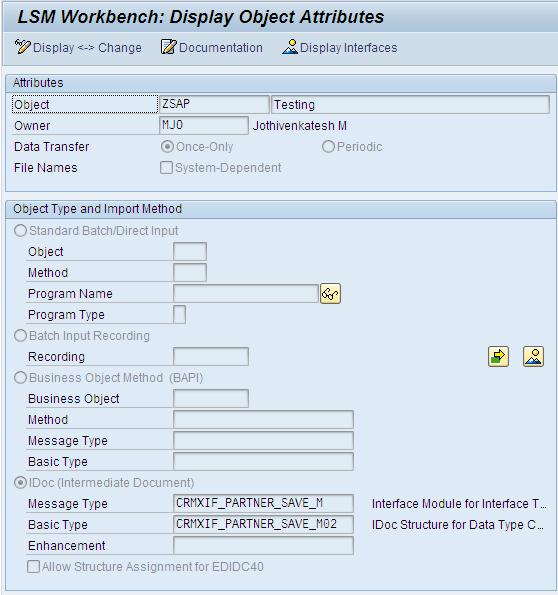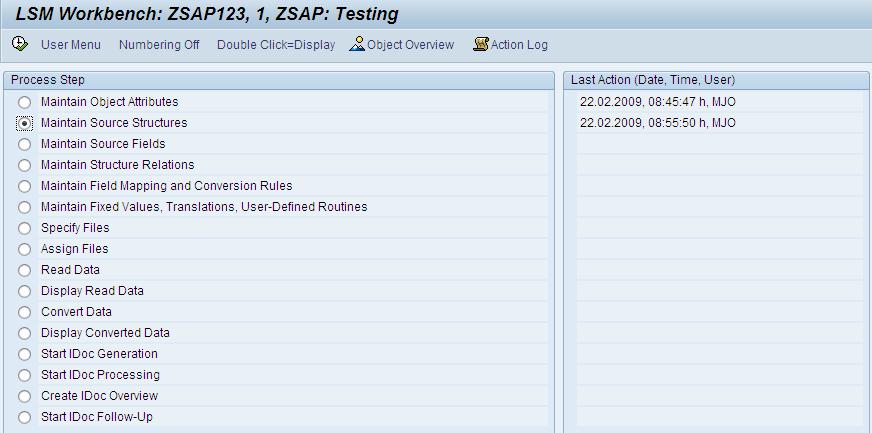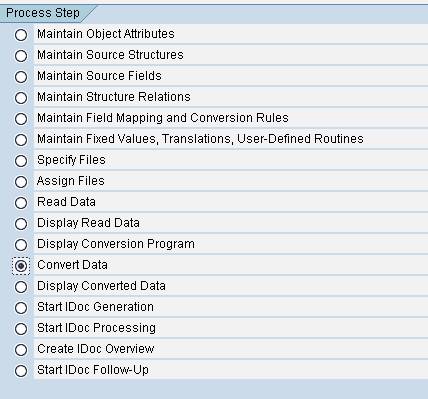
- SAP Community
- Products and Technology
- CRM and Customer Experience
- CRM and CX Blogs by SAP
- LSMW and XIF - Idoc method
- Subscribe to RSS Feed
- Mark as New
- Mark as Read
- Bookmark
- Subscribe
- Printer Friendly Page
- Report Inappropriate Content
Some times when the Master data are to be uploaded from a legacy system or from any other non connected, non SAP systems LSMW will come to the rescue. LSMW can be expanded as Legacy System Migration Workbench. This is to migrate the business entities into the CRM system. This tool actually contains following methods in which we can import data to CRM system:
- Standard Batch / Direct Input
- Batch Input Recording
- BAPI
- IDOC.
Out of these methods we will have a look into the steps of the importing business partners using Idoc method.
Step 1: Create project using transaction LSMW

Step 2: Select Maintain Attributes Radio Button:

Step 3: Maintain Attributes
Select Idoc Radio button and give "Message Type and Basic Type".

Click on Save.
Step 4: Activate Inbound processing.
The following screenshots explain the activation of Idoc Inbound processing.

Click "Idoc inbound processings" under settings.

Here maintain "Port" and "Partner type" and Partner number here and Press Activate Idoc Inbound processing.
Step 5: Maintain Source attributes

Click on "Maintain source structures" radio button. Click on Source attributes and then click on create.

Step 6: Maintain source fields


Step 7: Maintain structure relations


Click on structure relation and click on relationship as shown above to maintain relationship.
Step 8: Maintain field mapping

And press F8.

Extras ==> Auto field mapping. Press Enter until you get a popup message field mapping completed.
Step 9: Specify files


Click on the Legacy data while taking file from presentation server and click create.
Step 10: Assign files


Step 11: Read data


Step 12: Display Read data

Step 13: Convert Data


Step 14: Start Idoc generation

We will get popup like this:

Click Ok.
Step 15: Create Idoc overview

After this step, idocs will be created which can be viewed in transaction WE05. I hope this might help who try to import the Business objects using Idoc method of LSMW. For illustration purposes i have combined partners and orders in few places. This is a guideline for LSMW Idoc input method.
- SAP Managed Tags:
- SAP Customer Relationship Management
You must be a registered user to add a comment. If you've already registered, sign in. Otherwise, register and sign in.
-
Business Trends
270 -
Business Trends
11 -
chitchat
1 -
customerexperience
1 -
Event Information
256 -
Event Information
18 -
Expert Insights
30 -
Expert Insights
51 -
Life at SAP
133 -
Life at SAP
1 -
Product Updates
666 -
Product Updates
24 -
SAP HANA Service
1 -
SAPHANACloud
1 -
SAPHANAService
1 -
Technology Updates
453 -
Technology Updates
15
- How to find load method for an object in SAP? LLike BAPI Or IDOC or Migration cockpit in CRM and CX Questions
- ERP to C4C Business Partner Replication in CRM and CX Questions
- SAP Warranty Recall business process-2 in CRM and CX Blogs by Members
- Order not going to SAP ERP from DATAHUB in CRM and CX Questions
- SAP CAR Omnichannel Article Availability and Sourcing (OAA) in CRM and CX Blogs by Members
| User | Count |
|---|---|
| 4 | |
| 2 | |
| 2 | |
| 2 | |
| 2 | |
| 1 | |
| 1 | |
| 1 | |
| 1 | |
| 1 |